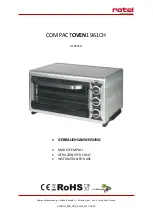
39
ELECTRIC CONVECTION OVENS
EN
3 - THIRD PART_Operating instructions
2.9.5 - Handle and hook
Proceed as follows:
1) Open the oven door
2) Unscrew the screws (A - pict. 11).
3) Replace and reassemble everything in reverse order.
4) If necessary, turn the nut (B - pict. 11) of the hook in a clockwise
or anti-clockwise direction to adjust the proper closing of the handle,
ensuring that the tip of the hook is facing in the right direction.
A
A
B
pict. 11
3.1 - Preliminary warnings
• The appliance is designed for professional use and must be used
by trained personnel.
• The oven must be used for cooking food only.
Any other use shall be considered improper.
NEVER clean the inside of the oven or the door glass with jets
of cold water when still at temperatures higher than 70 °C.
• All installation and non-routine maintenance work must be
carried out by authorized personnel with the required professional
qualifications only.
• It is best to have the oven checked at regular set intervals. Contact
authorized Support Centres only for repairs, and ask for original
spare parts to be used.
• If you encounter a fault or malfunctioning, switch off the appliance’s
power supply with the master switch and close the water supply cock
on the appliance’s supply line.
• Contact authorized Support Centres for repairs. The end user is
required to perform only routine maintenance on the oven, namely
checking the oven’s general efficiency and cleaning it daily.
Failure to fulfil these duties shall relieve the Manufacturer of
any liability.
• Read this manual carefully as it contains important information
and instructions regarding safety during installation, use and
maintenance. Keep it safe for future reference.
• Surfaces liable to come into contact with food must be cleaned
thoroughly before switching on the oven.
2.9.6 - Cooking chamber resistors
1) Work from the right-hand side of the oven to disconnect the
electrical connections from the resistors.
2) Remove the grill supports and the conveyor in order to access the
chamber resistors.
3) Unscrew the screws that secure the resistor flange to the chamber.
4) Replace the resistors and put everything back in position in
reverse order, remembering to replace the silicone where present
(use silicone which can resist temperatures of 300 °C).
















































